The 1980s Channel 4 Mapp & Lucia series, currently enjoying its 40th anniversary, has sparked off a fresh wave of interest in EF Benson’s novels, and is now being celebrated with a re-showing on Rewind TV.
This, in turn, no doubt, will propel new devotees, in the shape of extra visitors to Rye, and will almost certainly spark their curiosity in discovering the film locations where London Weekend Television shot the series, which was originally aired on Channel 4 in 1985 and 1986.
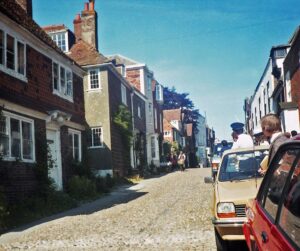
Series One consists of five episodes from the 1931 Mapp and Lucia novel, and Series Two, filmed a year later, is an adaptation of Lucia’s Progress (1935). The first three episodes and the final two episodes are based on the book, Trouble for Lucia (1939).
The series concentrates on the novels that were primarily set in Rye. Although the episodes begin in the fictitious town of Riseholme, which the author based on Broadway, Worcestershire – the rest of the series concentrates on those episodes based in Tilling (a fictitious name for Rye, which the author obviously adapted from the name of the River Tillingham, which flows through Rye).
The Riseholme segments were actually shot on location in the village of Chilham in Kent. The village itself is a beautiful 15th century time-warp with a castle, mentioned in the Domesday book. There is a wealth of information about Chilham which can be located via good old Google – as can most things!
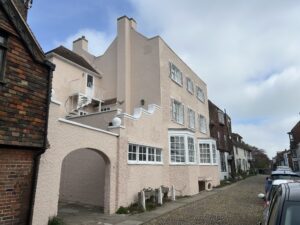
Most of the activity in the Tilling novels was set in Mallards House, originally based on EF Benson’s own home, Lamb House, now owned by the National Trust and open to visitors, although in the Channel 4 series, Swans House Cottage, the large and distinctive pink building in Watchbell Street was used instead. I recall one of the crew telling me at the time of filming, that this was probably because Watchbell Street was off the beaten track and Lamb House attracts a lot of footfall. He said Swans House Cottage was used also because it had the bay window feature, from which Miss Mapp, in the novels, would spy on her neighbours. In the event, this location worked very well as it has the character, and the cobbles.
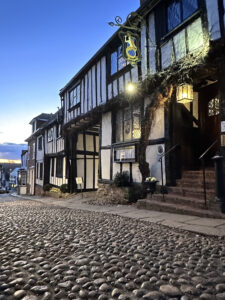
In the first episode, Lucia and Georgie, on their first visit to Tilling, spend the night at the Trader’s Arms, actually the world-famous and very distinctive Mermaid Inn, in Mermaid Street. This thoroughfare was also used as the setting for Twistevants, the grocer’s shop, which, in the series, is on the corner of Mermaid Street and West Street.
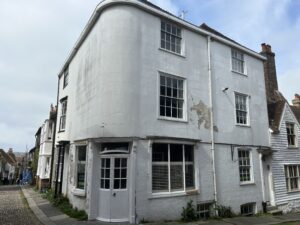
In the novels, the house named Wasters, the home of Godiva Plaistow, is set in the High Street but the location used in the Channel 4 TV series is 11 Watchbell Street, in common with other locations including the Major’s house. The crew selected the latter street because the former is the busiest thoroughfare in Rye, which would have made filming nigh on impossible.
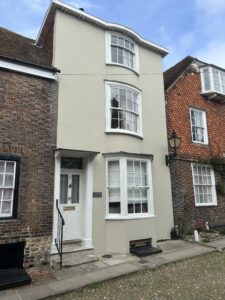
Georgie Pillson’s original residence in Tilling, Mallards Cottage is across the street from the Mallards House setting, Swans House Cottage, and is number 29 Watchbell Street – which is the identical setting used in the original novels.
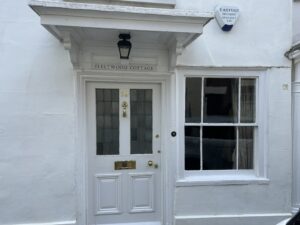
A short walk away at number 3 Church Square is the distinctive building that featured in the series as Quaint Irene’s house. You may remember the scene where she painted coloured diamonds onto the white clapboard exterior. As with all the Rye locations, 40 years later it still looks the same – minus the coloured diamonds unfortunately!
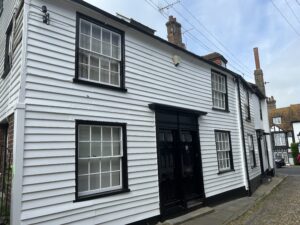
Back in Watchbell Street, Major Benjy’s house is located at number three, and you can see, yet again, how convenient it was for the crew to have all the locations close to each other. It would have saved closing down all the different locations used by the author in his novels; this would have infuriated the tourists, and in turn, the residents of Rye.
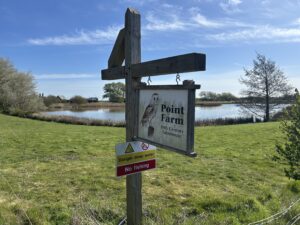
To locate Lucia’s Grebe you would have to leave the town on the A259 and turn right towards Lydd. This is the Camber Road where you will find Grebe, aka Point Farm, just off the Camber Road. This is now a bed and breakfast so you may even be lucky enough to get a room for your visit. Point Farm, a farmhouse built in 1824, is set in rural surroundings, next to a lake which is home to many wetland birds and creatures – and the odd sheep! However, the famous sea wall behind which the fictional house is set is not visible at this point, as the house is set back quite a way from the road. The sea wall can be seen at several points on the coast road nearby though, up to the Kent border at Broomhill Sands, where shipwrecks can be seen at low tide.
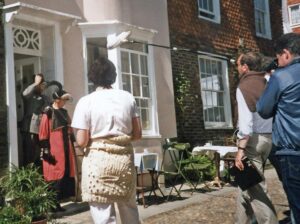
Other scenes were shot on location in Winchelsea, where the town’s ancient land gate was a substitute for its bigger sister in Rye; again the Land Gate in Rye is now a much-used thoroughfare and would also have posed logistical nightmares for the town during filming.
The sequences in which Miss Mapp and Lucia were seen returning from their impromptu trip with the Italian sailors in The Owl and The Pussycat episode, were filmed around the river estuary nearby, and they are seen trudging, clad in waterproofs and boots, past another great and ancient Rye attraction, Ypres Tower (aka Rye Castle). The scene in which Miss Mapp spies on Lucia from the top of the church tower, was shot atop St Mary’s Church, Rye, from which you can also hear the sound of its famous quarter boys bells in one of the episodes.
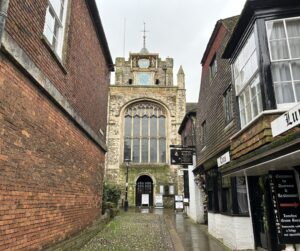
You can climb to the top of the tower yourself on selected open days. Fantastic views of the town and surrounding countryside but you can’t see Lucia’s garden. The ”crooked chimney” exists but is actually located atop a house in nearby West Street.
Nearby Camber Sands was used in the sequence where Major Benjy is playing golf with Mr Wise, during which the upturned kitchen table from The Owl and The Pussycat episode is spotted washed up on the shore.
Last but not least is the Duchess of Sheffield’s haunt, Sheffield Castle. Obviously nowhere near Sheffield, or Rye. This is Kent’s own grand residence and former home of Henry VIII’s Anne Boleyn, Hever Castle, another absolute must for those wanting to do “the tour”. Both the books, and the series, provide a great plan for a break on the Kent and Sussex border whilst taking in the wonderful town and landscape that will forever, for me – and many others – be the backdrop for some of the greatest characters ever to inhabit a superb piece of literature.
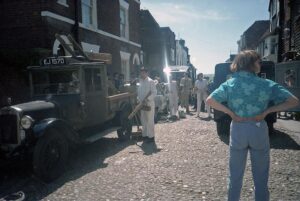
Finally, all of the characters in the novels were inspired by real people that were around the town at the time EF Benson was living there. We can still see the locations today but oh how wonderful would it be if we could ever find out who the characters were based upon. Now THAT would really complete our tour of Mapp and Lucia haunts, wouldn’t it?
You can read more about the filming, with rare archive pictures, here.
Image Credits: Kim Rye , James Stewart , Kt bruce .



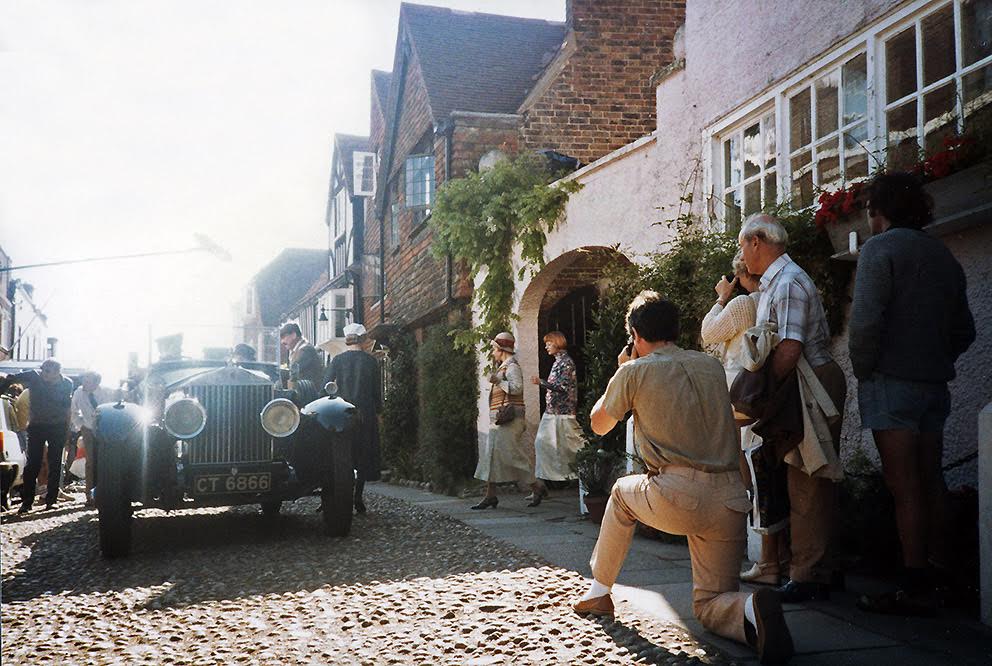
If you’d like to explore the film locations I built a website for the E F Benson society many moons ago which can still be found here https://mappandluciarye.uk/
How lovely to see my grandparents house the Swan’s House formally The White House in Watchbell Street. Rye
Both my cousin and I say when we can’t sleep we wander from room to room and of course the old garden opposite which went all the way down the old cliff in terraces.
I preferred the more recent version, about ten or 11 years ago that was broadcast christmas time. Steve Pemberton was brilliant as georgie and lucias clothes left me in a swoon. Really enjoyed it.
They are both important in their own way. Different times, different production values and budgets. But the original 1980’s version truly put Rye on the map (Mapp). We came to Rye before the 1980’s TV series was made, and was struck by its beauty. The TV series that followed simply enhanced how special a place it is. And the next TV production did the same. Though the later series did not outshine the iconic performances and camp of Geraldine McEwan and Prunella Scales. However, many people come to Rye from all over the world not due to a TV series, but because of the original books by E.F. Benson